TORONTO (Oct. 22) — It has not happened in the modern history of the Toronto Maple Leafs.
Until now.
Never before have the Leafs embarked on a five–game road trip without print–media representation. As occurred for the first two matches of this season–long trek through Sunrise, Fla., Tampa, Washington, Dallas and Nashville.
All of the current beat–writers — Lance Hornby and Terry Koshan of the Toronto Sun; Kevin McGran and Mark Zwolinski of the Toronto Star and Marty Klinkenberg of the Globe and Mail — remained home, covering the Florida portion of the trip off television. Only the team–owned sports networks had reporters on site: Shawn McKenzie and Luke Fox for Sportsnet; Mark Masters for TSN. What a sad and dramatic change from the years (1993–2010) I covered the hockey club for The FAN–590. During that time, a long road trip would be staffed by a beat–writer and columnist from the two Toronto dailies; a writer from the national paper (the Globe) and yours truly from radio. I was always accompanied on lengthy trips by either Hornby, Koshan, Rob Longley or Mike Zeisberger of the Sun (along with columnists Al Strachan or Steve Simmons); Frank Orr, Paul Hunter or Zwolinski and columnists Damien Cox or Rosie DiManno of the Star; David Shoalts of the Globe and Mail. In my latter years, TALK–640, the Leafs radio partner at the time, sent young reporter Jonas Siegel on the road. With broadcasters and technicians from the CBC or the club’s regional TV partner (Global); intermission host Mark Hebscher; play callers Joe Bowen and Jim Ralph (radio); Bob Cole and Harry Neale (TV); Ron MacLean and Don Cherry for Saturday road matches, the Maple Leafs were surrounded by an enormous media crowd. Today? Next to nothing.
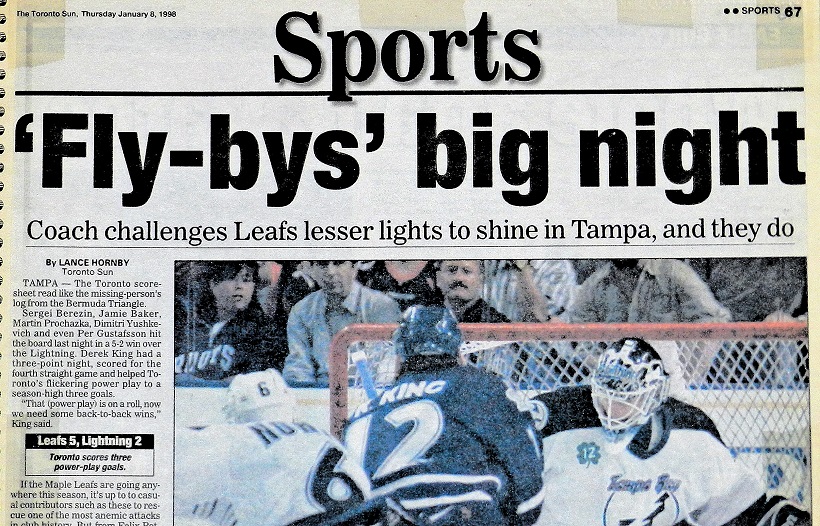
THE MAPLE LEAFS WERE COVERED BY REPORTERS FROM THE TORONTO STAR, TORONTO SUN AND GLOBE AND MAIL FOR EVERY ROAD GAME IN RECALLABLE FRANCHISE HISTORY. INCLUDING JANUARY 1998 (ABOVE, WITH LANCE HORNBY OF THE SUN) IN TAMPA… AND DECEMBER 1977 (BELOW, WITH JIM CHRISTIE OF THE GLOBE IN BLOOMINGTON, MINNESOTA). TRAVEL BANS AND RESTRICTIONS DURING THE COVID–19 PANDEMIC CHANGED THE CUSTOM. PERHAPS FOR GOOD.

The newspaper industry had already been decimated by the Internet when COVID appeared and severely restricted travel over parts of two NHL seasons. Confined to their homes, reporters covered games off TV and waited for wire reports to insert quotes. Clearly, it saved media outlets enormous sums of cash, a trend that continues today with the pandemic largely in the past. Travel budgets for hockey have either been eliminated — as at the Sun — or drastically reduced, as at the Star. The Globe and Mail sent Klinkenberg on the road with the Leafs in the playoffs last season. Today, only one Internet writer not employed by Rogers or Bell follows the team to every game: my former radio colleague, David Alter, for Sports Illustrated Canada and The Hockey News. The Star and Sun, always staffing Leafs road matches prior to the pandemic, are nowhere to be found on the current trip.
Given that so few readers actually buy a physical paper anymore — obtaining news and opinion off their mobile devices — travel budgets will not be restored. Most hockey fans today are oblivious to the absence of on–site reporters. The Leafs have adroitly fed this trend by tightening player availability through the years. When I began covering the team in the early 90’s, it was common for reporters to encounter a nearly full dressing room; players seated in their assigned positions. Access was easy, plentiful and often enjoyable. Today, the rooms are deserted after games. Media relations personnel fetch the athletes, one at a time, for common media scrums. Everyone gets the same sound, as if provided by pool reporters. Sitting down with a subject for an exclusive story is a lost convention. As it will remain. The players like it — media has always been the necessary evil — and the publicity hounds are happy with a reduced workload. Newspaper editors no longer deem it necessary to pay for travel.
But, I can tell you this: Any person that has followed a professional sports team will agree there is no substitute for being on site. Sure, you can pluck clichés from wire services and TV clips. But, there is no chance to unearth an exclusive angle or story from the living room or den. Coincidentally, it was my situation at The FAN–590 that kickstarted the money–saving trend. For 14 seasons (1994–95 to 2008–09), I made every trip with the Maple Leafs — the first few years while the team resided in the Western Conference and routinely traveled to the Mountain and Pacific time zones. There was nothing cheap about flying to Los Angeles, San Jose, Phoenix, Denver and Dallas two or three times per season. And, to western Canada on three occasions. Costs were somewhat mitigated, in 1998–99, when Ken Dryden returned the Leafs to the Eastern Conference. But, the invisible suits in the ivory tower at Rogers — led by a ruthless corporate slasher named Paul Ski — eliminated travel for a position that remains tailored to radio. The live/instant news edge I enjoyed over my Leaf reporting colleagues in the early years became tenuous when social media erupted. Still, with hundreds of thousands confined to their automobiles in traffic–choked Toronto, there should always be a place for radio reporting of the Leafs. Drivers, by law, cannot consult their mobile devices until reaching a destination. They can listen to AM radio through all hours of the day.
Trusty tape recorder and microphone in hand, I regularly offered information and opinion fans could obtain, in real time, nowhere else. Which remains conceivable in our current media environment, even if a pipedream.
GLEN THE PROPHET: For close to 30 years, former defensive back Glen Suitor has been the premier Canadian Football League analyst on TV. As part of TSN’s No. 1 broadcast tandem (with veteran play caller Rod Smith), Suitor is the answer, north of the border, to Tony Romo of FOX Sports. Both are adept at predicting which plays will be called and recognizing patterns. At the outset of Saturday afternoon’s telecast from Mosaic Stadium in Regina, Suitor warned viewers of the risk the Toronto Argonauts assumed by deploying No. 1 quarterback Chad Kelly in another meaningless game; the club having locked up first place in the CFL East with one–third of the schedule remaining. Every time coach Ryan Dinwiddie permitted Kelly to leave the sideline, Suitor offered a cautionary tale. “We are one hit from Cameron Dukes,” noted the TV analyst about the Argos potentially needing to play their raw, untried back–up. Of course, the same applies to every team with respect to its starting pivot, though other CFL clubs have more experience in reserve. The Argos are fully dependent on a healthy No. 12 in double blue to defend their Grey Cup title from a year ago. When Kelly had his ankle twisted on a third–quarter tackle by Anthony Lanier of the Roughriders and hobbled toward the sideline, Suitor quickly intoned “… and that’s what I’m talking about. In my opinion, Chad Kelly has played nearly three quarters too long in this game.” Dukes entered the match and ultimately drove the Argonauts to a winning touchdown with 57 seconds left on the clock.
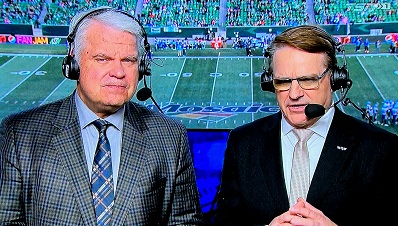

GLEN SUITOR (IN DARK JACKET) TALKS WITH CONCERN ALONGSIDE ROD SMITH AFTER ARGOS QUARTERBACK CHAD KELLY HAD HIS RIGHT ANKLE TWISWTED LATE IN THE THIRD QUARTER AT REGINA. KELLY SEEMED OKAY AFTERWARD.
Toronto eliminated Saskatchewan from playoff contention with a 29–26 triumph.
Kelly’s limp was less pronounced at the conclusion of the game and he told TSN sideline reporter Brit Dort “I’m fine… I’m fine.” Still, Suitor came off like a genius after his repeated admonition of the Argos for continuing to play Kelly. There are, of course, two sides to the issue. Yes, every down in football is accompanied by an injury risk. Still, contending teams almost always stay with their No. 1 quarterback throughout the season. The late Don Matthews would have needed a crane to remove Doug Flutie from late–season matches when the Argos won consecutive Grey Cup titles in 1996 and 1997. The gap between Flutie and his back–up, Andre Ware, was similar to that of Kelly and Dukes. No one batted an eyelash when Flutie continued to play. Neither did TSN announcers Dustin Nielson and Matt Dunigan pound away nearly as much in the late game, Saturday, over Mike O’Shea deploying Winnipeg starter Zach Collaros for three quarters of a lopsided victory over Edmonton. The Blue Bombers had clinched first place in the CFL West when Calgary trampled B.C. on Friday. Now, the Argos must ensure that Kelly is in top shape for the Eastern final at BMO Field on Nov. 11. That means not dressing him for the season finale, next Saturday, in Ottawa while providing him lots of rest and rehab. We likely will not receive an update on Kelly until Wednesday, when the Argos practice and Dinwiddie talks to reporters. Toronto has equaled a franchise record (set by the Flutie teams) of 15 wins in a season, which is also tied for the second–most in CFL history.
It will be largely in the hands of second and third–string players, at Lansdowne Park, to author a 16th victory, matching the league record of the 1989 Edmonton Eskimos. With 30 points, Toronto is guaranteed to post the top mark in the CFL this season. The Argos will host either the Alouettes or Tiger–Cats in the regional final on home turf; Hamilton traveling to Montreal for the East semifinal on Nov. 4. It’ll be Calgary at B.C. in the West semi.
“Touch ’em All Joe!”…
Time continues to play tricks as we grow older.
Any person with first–hand recollection of 30 years ago this week will probably marvel at the juncture between Oct. 23, 1993 and today. It’s difficult to fathom that 30 years prior to the night Joe Carter won the World Series for the Toronto Blue Jays was Oct. 23, 1963 — or one month before president John F. Kennedy was assassinated in Dallas. The latter three decades have come and gone far quicker than the first… or so it definitely seems.
I had the privilege of covering the 1993 American League Championship and World Series for The FAN–1430, just more than a year after we launched Canada’s first all–sports radio station (to become The FAN–590 in February 1995). I also covered the Blue Jays the previous Autumn, when Toronto defeated Oakland and Atlanta for its first Major League title… and the first for a team outside the United States. In ’93, it was the Chicago White Sox in the ALCS (Blue Jays prevailed in six), then the Philadelphia Phillies in the World Series. Carter, now long–legendarily, smacked a three–run homer off erratic closer Mitch Williams in the bottom of the ninth at SkyDome, winning Game 6 and the baseball championship for a second consecutive year. Minutes earlier, the Maple Leafs had prevailed in Tampa Bay, setting a National Hockey League record of nine wins to start the season. It was Oct. 23.
Carter’s blast to left field was immortalized by the Blue Jays original radio voice, Tom Cheek, who famously intoned “touch ’em all, Joe. You’ll never hit a bigger home run.” Sadly, Tom died just 12 years later of brain cancer.
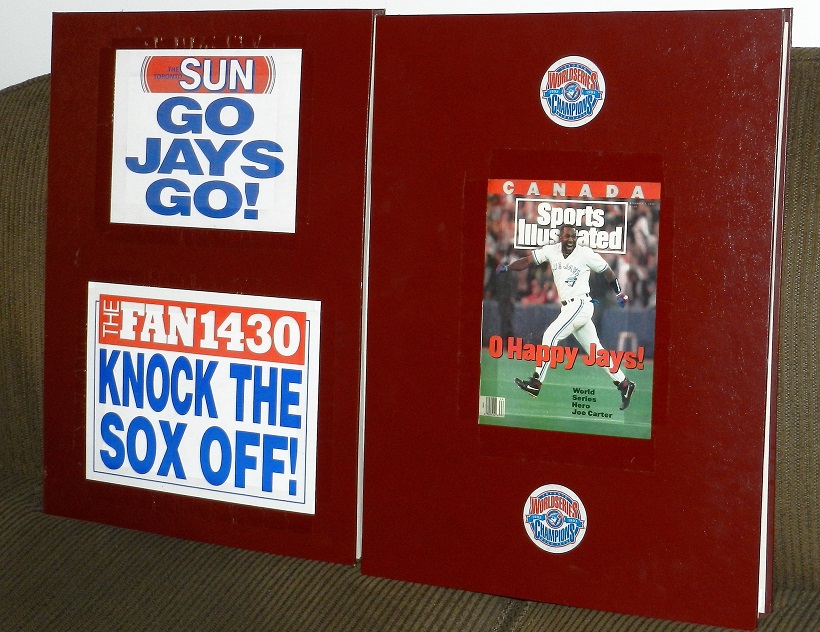
As I traveled through the baseball playoffs each year, I collected newspapers from Toronto and the respective road cities. The old Grand & Toy outlets sold heavy cardboard scrapbooks that measured 25½ x 19 inches, large enough to accommodate full broadsheet and tabloid pages. My scrapbooks from the 1993 ALCS and World Series are pictured, above. The title round featured the highest–scoring affair in Series history: Game 4 at old Veterans Stadium that spawned a unique cover (bottom–left) to the Toronto Sun (cover of the Toronto Star, right).
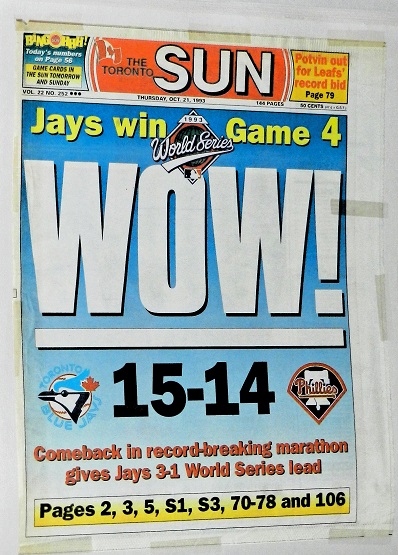
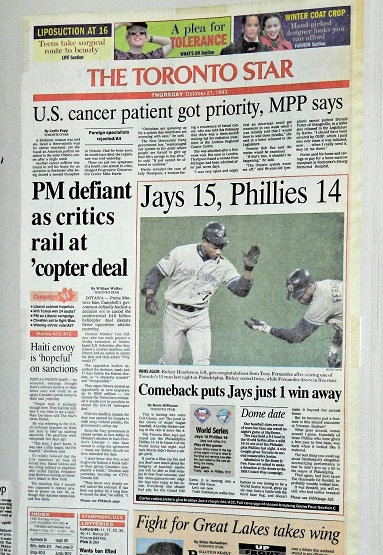
Here are more images from my scrapbook after the Blue Jays had stunned the Phillies:
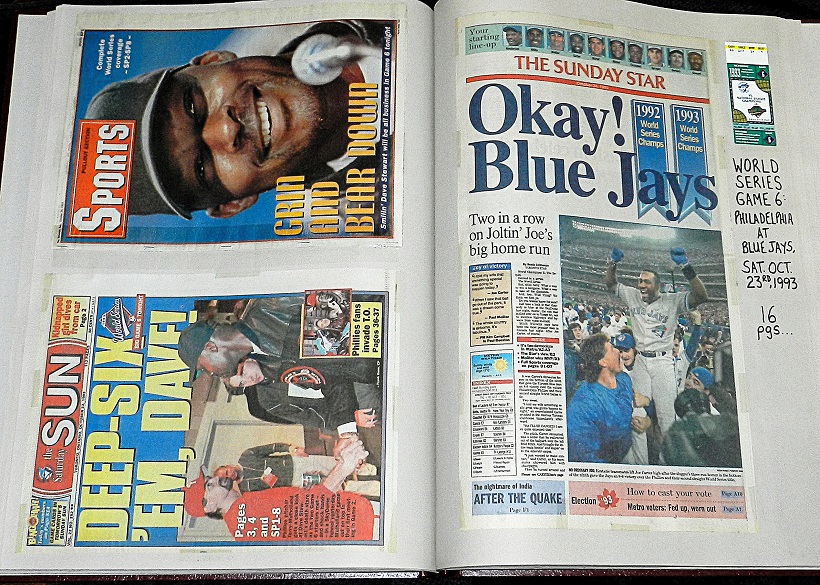
FULL FRONT PAGE (TOP–RIGHT) OF THE TORONTO STAR WITH A SKYDOME TICKET STUB FROM DAD, WHO ATTENDED THE MATCH. THE FRONT SPORTS PAGE (BOTTOM–LEFT) SHOWED PAUL MOLITOR HOLDING HIS WORLD SERIES MVP TROPHY.
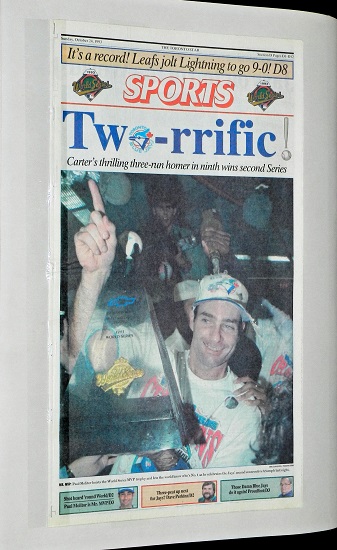
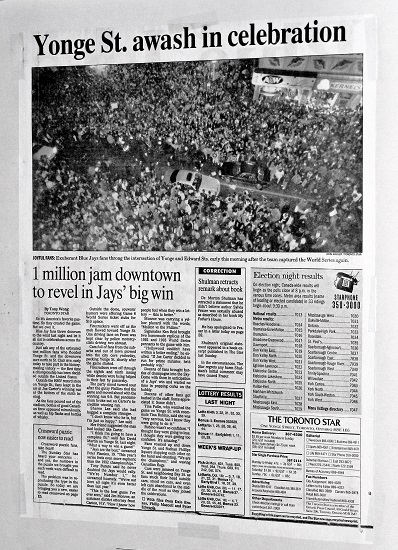
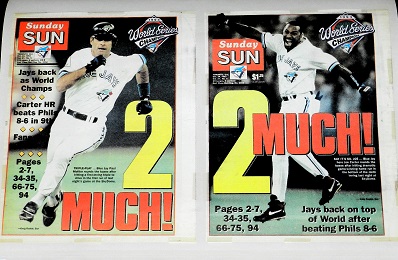
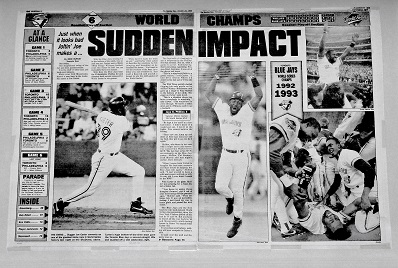
FRONT PAGES OF THE TORONTO SUN (TOP–LEFT) — EARLY AND FINAL EDITIONS. GAME STORY (RIGHT) BY MIKE RUTSEY.
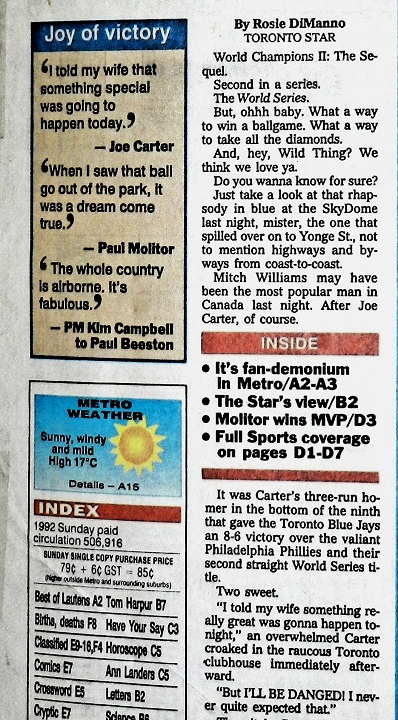
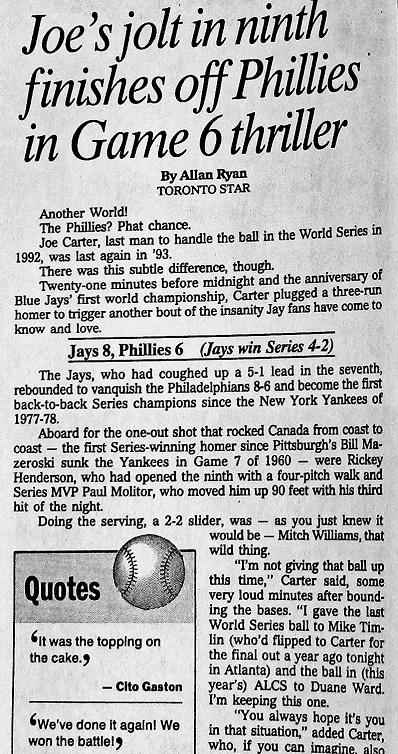
TORONTO STAR FRONT–COVER STORY (LEFT, BY ROSIE DiMANNO) AND SPORTS LEDE, BY ALLAN RYAN.
EMAIL: HOWARDLBERGER@GMAIL.COM




































The job description of the media relations director of a professional sports team has changed drastically over the past decades. Media relations is now a team within a team.
As you would know, Potsie.
The Landscape pertaining to sports reporting has definitely changed, post Covid, and not in a good way.